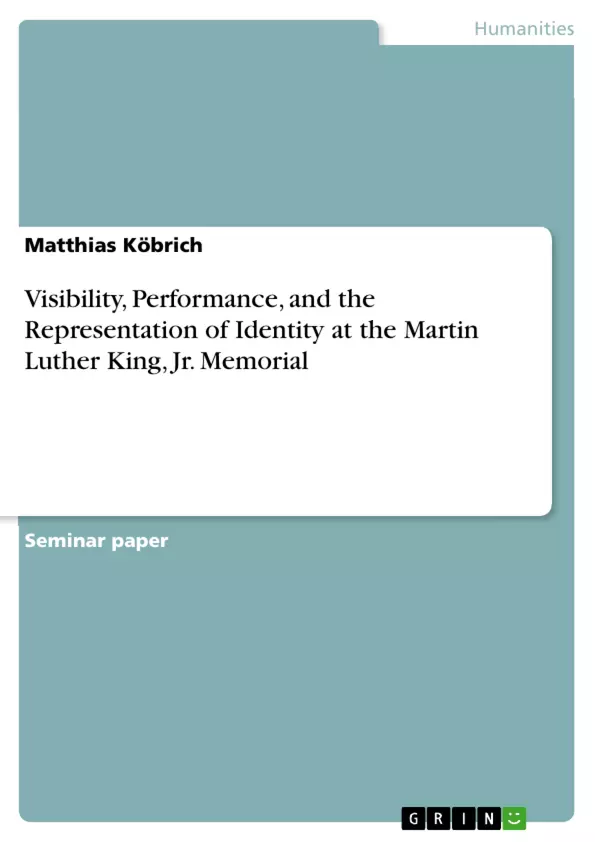The Martin Luther King, Jr. Memorial, which, since 2011, is located in the southwest of the National Mall in Washington D.C., was designed and built by Chinese sculptor Lei Yixin. It commemorates the civil rights activist that was murdered in 1968, the history of the civil rights movement of Afro-Americans, as well as the issues the movement dealt with and propagated. It was, like many other memorials throughout the USA, also subject to criticism, regarding its design, layout, material, expressiveness, the choice of its creator, and thus also its overall ‘Americanness’.
In this paper, the focus will be on the questions of how this memorial works and why it works in a specific way. A memorial can serve many different purposes, such as to grieve, remember, recognize, celebrate, support, help to forget, heal, confront, equalize, understand, educate, acknowledge, etc. It will be argued that memorials are not only about the physical site, the monument or the venue in general, they are also to a huge extent about a number of external or complementary factors, such as the visitors or spectators of the site in question, and their respective performances with regard to the site of memory. Thus, a memorial never has a fixed meaning or message – to a certain extent, a memorial is always a floating signifier with meanings in constant flux, depending on its current social environment and various power relations.
The visibility and interpretation of such ‘lieux des mémoire’ is of course also heavily dependent on contemporary discourses, as well as individual and national identity. The terms identity, performance, visibility, and the site’s ‘Americanness’, or in other words, what the afore-mentioned topics tell us about American culture in the general sense, and a presumed American ‘culture of memory’, will be at the center of this paper about the Martin Luther King, Jr. Memorial.
Inhaltsverzeichnis (Table of Contents)
- Introduction
- Visibility, Performance, Identity, and the Martin Luther King, Jr. Memorial Site
- Visibility
- Performance
- Identity
- The Martin Luther King, Jr. Memorial Site
- Through the Lens of Visibility, Performance, and Identity
- Visibility at the Martin Luther King, Jr. Memorial Site
- Performance at the Martin Luther King, Jr. Memorial Site
- Identity at the Martin Luther King, Jr. Memorial Site
- Conclusion
Zielsetzung und Themenschwerpunkte (Objectives and Key Themes)
This paper analyzes the Martin Luther King, Jr. Memorial through the lenses of visibility, performance, and identity. It aims to investigate how these concepts can be applied to memorial sites and the act of commemorating. The paper seeks to understand how the memorial defines the USA, what kind of identity it creates, and how it represents and represses national consciousness.
- The role of visibility in shaping national narratives and agendas.
- The performance of identity and memory at memorial sites.
- The intersection of identity, power, and representation in the context of memorials.
- The potential for memorials to both unify and divide national consciousness.
- The role of memorials in shaping cultural memory and understanding.
Zusammenfassung der Kapitel (Chapter Summaries)
- Introduction: This chapter introduces the topic of memorials in the United States, highlighting their diverse nature and significance in shaping cultural memory. It establishes the central focus of the paper on the Martin Luther King, Jr. Memorial and its multifaceted meanings.
- Visibility, Performance, Identity, and the Martin Luther King, Jr. Memorial Site: This chapter provides a theoretical framework for understanding the memorial. It introduces the concepts of visibility, performance, and identity, emphasizing their interconnections and relevance to memorial sites.
- Through the Lens of Visibility, Performance, and Identity: This chapter applies the theoretical concepts introduced in the previous chapter to the specific case of the Martin Luther King, Jr. Memorial. It analyzes the memorial's physical design, symbolic representations, and visitor experiences, exploring how these elements contribute to its meaning and impact.
Schlüsselwörter (Keywords)
This paper explores the interplay between visibility, performance, and identity in the context of the Martin Luther King, Jr. Memorial. Key themes include cultural memory, national identity, American culture, memorial sites, and the representation of history.
- Quote paper
- Matthias Köbrich (Author), 2016, Visibility, Performance, and the Representation of Identity at the Martin Luther King, Jr. Memorial, Munich, GRIN Verlag, https://www.grin.com/document/345294



